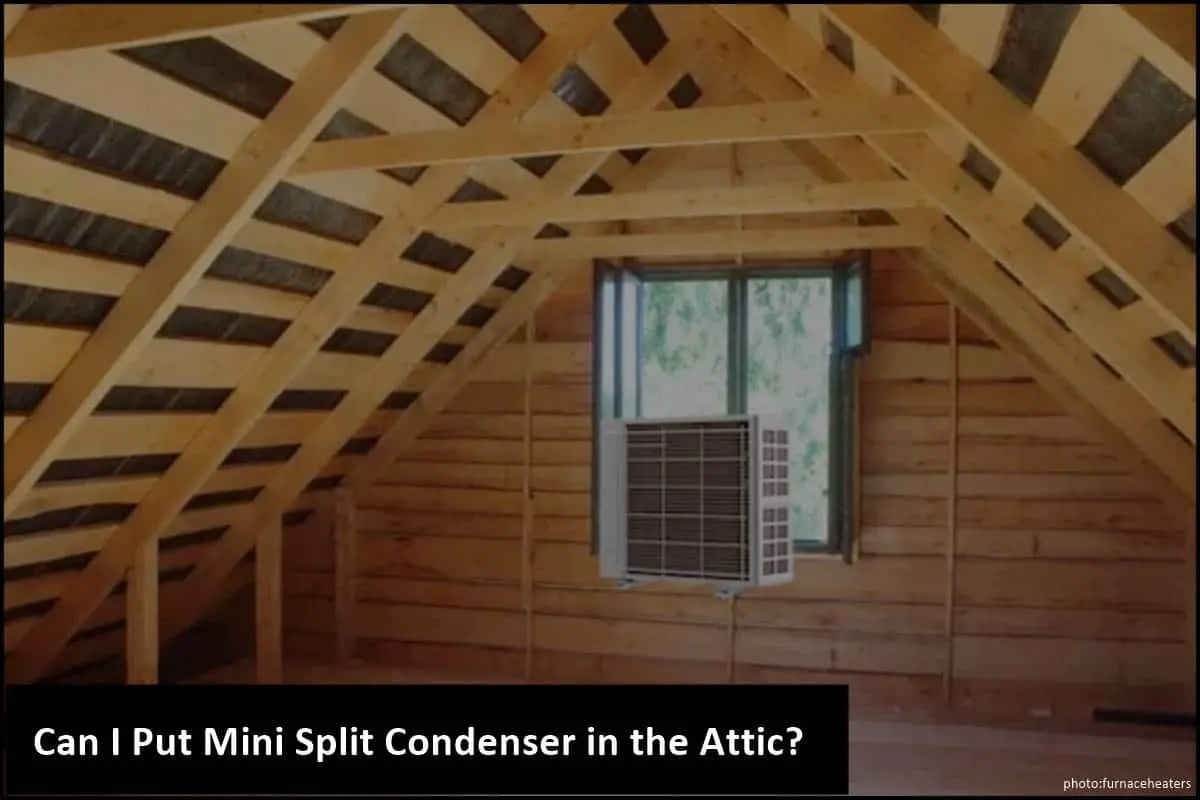Are you considering installing a mini split in attic? You’re not alone. Many homeowners are exploring this option to save space and achieve a more seamless look in their homes. However, before you make a decision, it’s important to understand the factors involved in the installation of the mini split condenser in attic.
The answer to your question that Can you put a mini split condenser in attic depends on many factors. Typically, installing a mini split condenser in the attic is not advisable. However, it can be done if the temperature within the attic falls within the recommended operating range specified by the manufacturer of the mini-split system.
Pros & Cons of Installing a Mini Split AC Unit in the Attic
Installing a mini split in the attic has several advantages and disadvantages. Let’s take a closer look at the pros and cons of this installation method.
Pros
Space-saving
One of the main advantages of installing a mini-split condenser in the attic is that it frees up valuable outdoor space. This can be particularly beneficial if you have limited outdoor space or if you want to maintain a clean and uncluttered look for your home’s exterior.
Aesthetic appeal
By placing the condenser in the attic, you can achieve a more seamless and discreet appearance for your home. This is especially advantageous if you have architectural restrictions or if you want to maintain the overall aesthetics of your property.
Protection from the elements
Attics provide a level of protection from harsh weather conditions, such as extreme temperatures, heavy rain, and snow. By placing the condenser in the attic, you can help extend its lifespan and minimize potential damage caused by the elements.
Cons
Limited space and accessibility
Attics are often cramped and may not have sufficient space to accommodate a mini-split condenser. Additionally, accessing the condenser for maintenance or repairs can be challenging in a confined space, potentially leading to higher service costs.
Ventilation requirements
Mini-split condensers generate heat, and proper ventilation is essential to ensure efficient operation and prevent overheating. Attics may not provide adequate ventilation, which can affect the performance and efficiency of the condenser.
Noise concerns
Mini-split condensers can produce noise during operation. Placing the condenser in the attic may lead to increased noise levels inside the house, especially if the attic is not adequately insulated. This can be a significant drawback if you value a quiet and peaceful living environment.
Also read:
Should I Leave Air Conditioner Running on Low Heat all Night
Factors to Consider Before Installing a Mini Split Condenser in Attic
Before proceeding with mini split attic installation, there are several key factors you need to consider. These factors will help determine whether your attic is suitable for housing a mini-split condenser and ensure optimal performance and longevity.
Space Availability
Assess the available space in your attic to determine if it can accommodate the condenser unit. Measure the dimensions of the condenser and compare them to the available space. Keep in mind that the condenser requires sufficient clearance for proper airflow and accessibility for maintenance.
Attic Ventilation
Adequate ventilation is crucial for the efficient operation of a mini-split condenser. Check if your attic has proper ventilation, including vents, soffits, and insulation. Insufficient ventilation can lead to heat buildup, reduced performance, and potential damage to the condenser.
Structural Support
Consider the structural integrity of your attic. Ensure that the floor can support the weight of the condenser unit, as well as any additional weight that may be required for installation, such as support brackets or platforms. Seek professional advice if you have concerns about the structural capacity of your attic.
Noise Considerations
Evaluate the noise levels in your attic and the impact it may have on your living space. Attics tend to amplify sound, and the noise generated by the condenser may be more noticeable in this confined space. Consider soundproofing options or alternative installation locations if noise is a significant concern.
Accessibility for Maintenance
Consider how accessible the attic is for future maintenance and repairs. Attics can be challenging to navigate, especially if there are obstacles or limited headroom. Ensure that you can safely access the condenser for routine maintenance tasks such as cleaning or filter replacement.
Proper Attic Ventilation for a Mini Split Condenser
Proper attic ventilation is essential when installing a mini-split condenser in the attic. Inadequate ventilation can lead to reduced performance, increased energy consumption, and potential damage to the condenser. Here are some tips to ensure proper attic ventilation for your mini-split condenser:
Check existing ventilation
Assess your attic’s current ventilation system. Look for vents, soffits, or gable vents that allow air exchange. Ensure that these vents are not blocked or obstructed by insulation, debris, or other objects.
Calculate ventilation requirements
Calculate the required ventilation area based on the size and capacity of your mini-split condenser. Generally, a rule of thumb is to have one square foot of ventilation for every 300 square feet of attic space. However, it’s best to consult with a professional HVAC technician to determine the precise ventilation needs for your specific installation.
Install additional vents
If your attic lacks sufficient ventilation, consider installing additional vents or exhaust fans. These can help improve airflow and prevent heat buildup. Ensure that vents are strategically placed to promote cross-ventilation and allow for optimal air circulation.
Consider insulation
Proper insulation is crucial for maintaining a comfortable indoor climate and minimizing energy loss. Insulate the attic space to prevent heat transfer between the conditioned living areas and the attic. This will also help reduce the impact of noise generated by the condenser.
Remember, proper attic ventilation is not only important for the performance of your mini-split condenser but also for the overall health of your home. It helps prevent moisture buildup, mold growth, and other issues that can affect indoor air quality and structural integrity.
Also read:
Hisense Portable AC E5 Error Code (Instant Fix)
How to Install a Mini Split in Your Attic
If you’ve determined that installing a mini split condenser in your attic is the right choice for you, here are some tips to ensure a successful installation:
Consult with professionals
Seek guidance from HVAC professionals who specialize in mini-split installations. They can assess your attic’s suitability, provide expert advice, and handle the installation process efficiently and safely.
Choose the right condenser
Select a mini-split condenser that is suitable for attic installation. Consider factors such as size, weight, noise levels, and energy efficiency. Opt for models designed for compact spaces and ensure that they meet your specific cooling requirements.
Plan for adequate clearance
Ensure that the condenser has sufficient clearance from walls, ceilings, and other obstacles in the attic. This will allow for proper airflow, heat dissipation, and ease of maintenance. Refer to the manufacturer’s guidelines for recommended clearances.
Consider condensate drainage
Mini-split condensers produce condensate that needs to be drained. Plan for proper condensate drainage to prevent water damage and ensure efficient operation. Consult with professionals to determine the best drainage solution for your attic installation.
Insulate and soundproof
Insulate the attic space to minimize heat transfer and reduce noise transmission. Use insulation materials that are suitable for both thermal and acoustic insulation. This will help improve energy efficiency and create a more comfortable living environment.
Regular maintenance
Schedule regular maintenance for your mini-split condenser to ensure optimal performance and longevity. This includes cleaning or replacing filters, checking refrigerant levels, inspecting electrical connections, and lubricating moving parts. Follow the manufacturer’s maintenance guidelines or consult with professionals for recommended maintenance intervals.
Alternative Options for Installing a Mini Split Condenser
If installing a mini-split condenser in the attic is not feasible or suitable for your home, there are alternative options to consider:
Wall-mounted installation
Mini-split condensers can be installed on exterior walls, eliminating the need for attic placement. This option is particularly suitable if you have limited attic space or if wall mounting is more practical for your specific needs.
Ground-level installation
Another option is to install the condenser at ground level, either on a concrete pad or a platform. This allows for easy access, maintenance, and servicing. Ground-level installations are commonly used when outdoor space is available and accessible.
Roof installation
In certain cases, it may be possible to install the mini-split condenser on the roof. This option requires careful consideration of structural support, weatherproofing, and clearance requirements. Consult with professionals to determine if a roof installation is a viable option for your home.
Each alternative option has its own advantages and considerations. Assess your specific needs, available space, and installation requirements to determine the best option for your mini-split condenser installation.
Also read:
Why Split AC Not Cooling but Fan is Running
Cost Considerations for Installing a Mini Split Condenser in the Attic
Installation costs for attic installations of mini-split condensers can be higher than other options due to the added complexity and time involved. Accessing the attic poses additional challenges, leading to increased labor costs. Ensuring proper ventilation and clearance further contributes to the complexity of the installation process.
Depending on the attic’s condition and structural integrity, structural modifications may be necessary to support the condenser unit’s weight, incurring additional expenses for materials and labor. Ventilation upgrades, such as installing additional vents or exhaust fans, may also be required if the attic lacks sufficient airflow.
The costs associated with insulation and soundproofing solutions should be factored in to enhance energy efficiency and reduce noise transmission. Additionally, attic installations may demand more frequent maintenance due to accessibility challenges, impacting long-term costs.
When considering the installation of a mini-split condenser in the attic, it’s crucial to obtain quotes from multiple HVAC professionals. The overall cost can vary based on factors like location, condenser size, installation complexity, and any necessary modifications or upgrades. Evaluating these factors will provide a more accurate estimate tailored to your attic and home requirements.
Final Thoughts
Also, consider the cost implications when budgeting for an attic-installed mini-split condenser. Installation costs, structural modifications, ventilation upgrades, insulation, soundproofing, and maintenance expenses should all be factored into your decision-making process.

Hello, I’m James, the founder of FixitAllSecure.com. With over 10 years of experience in appliance repair, I’ve made it my mission to assist homeowners like you in resolving appliance issues, saving you precious time and money. From practical repair guides to prevention tips, I’m here to ensure your appliances run smoothly and your household stays stress-free.


